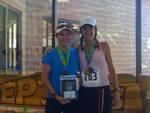What do you look forward to this time of year? In Colorado, it's the changing of seasons: the shifts of hues in the tree leaves that leave hillsides ablaze with color, the bugling of the elk, the cooler temps that inevitably bring snow...and for a bunch of us runners, marathon season!
Yes, marathon season is in full swing now, and no--non, runners--that's not when you can hunt down a marathoner! Fall is the time when most (though not all) of the major marathons occur, along with some smaller gems that one of my friends tend to find and race. This is the time when we want to see all of our consistent training pay off...all those early morning long runs, speedwork sessions, goal pace runs, recovery runs, and the cross training we've been doing. (And, of course, the nutrition we've hopefully dialed in as well as the REST we've been getting.) As some of my friends and teammates head off to their races, their "hay is in the barn" (and they must just now "feed the horses"), while I still have some hay stockpiling to do (5 weeks, to be exact: 3 weeks of "regular" training, followed by a 2-week taper).
And so I headed out in the early morning darkness (as usual) again today to do my goal pace run. (I have to interject here that I do enjoy running in the darkness. There's something almost magical about only being able to see the ground directly in front of you that removes that visual reference of where you are and how far you've gone versus where you're going and how far you've gone.) The weather folks said that we'd have a cool front moving in today, so I was prepared for--and actually looking forward to--a cooler run. I've been a little tired this week, having volunteered at a race on Sunday and probably also just due to where I am in my training cycle, so I wasn't sure how this goal pace run would go. I adjusted my expectations a little, but not so much that I'd be disappointed in the target pace I was hitting.
Now, when I do my goal pace training runs, I deliberately start slowly to warm up, but gradually pick up the pace with each successive mile prior to the actual goal pace section, so that moving to the goal pace miles doesn't seem like such a big shift. I've found that works well for me, and makes that transition much smoother. This morning, even though I'd adjusted my expectations of my target goal pace to be a bit slower, something was clicking in those miles. I found that I was holding my target pace (for this morning, at least) pretty exactly mile after mile after mile. Given that I was tired going into this run, you'd better believe that there were several times that I wasn't sure I was going to keep up the pace. There were times when it wasn't comfortable to keep going--today, my hamstrings were arguing with me a bit--and the wind gusts made sure to hammer that feeling home this morning. Somehow I kept my inner metronome going and repeated "I can do this, I can do this..." to the rhythm of my footfalls and breathing. "Keep the turnover quick, watch your form...". (I mean seriously. This was a morning when I have to admit that the thought of sleeping in did cross my mind for a split-second, because I knew I was just tired and that this was probably going to hurt a little. Not as in "injury" hurt, but as in "dipping into the pain bucket because you're pushing yourself" hurt.) Mile after mile, though, I was able to nail the goal pace I'd told myself I could live with this morning, and then something happened in that final mile. Without planning it, and I think simply because I was trying to keep the effort constant, the final mile ticked away at a slightly faster pace. And then, the beep of my Garmin signaled the end of goal pace miles and one final, recovery pace mile. Ahhhhh...a comfortable, easy pace for my last mile back to the car!
This morning's run--along with every race I've run this summer and fall so far--reminded me that I have to be willing to "dip into the pain bucket" and endure the discomfort during my race(s) if I want to PR, BQ, or RAFASP (run as fast as smartly possible). (And thank you to my friend who challenged me to do so after I ran Boston last April.) I have a "pain bucket" theory. There's the discomfort of the marathon in and of itself, and then there's the discomfort of pushing yourself and your pace (as fast as SMARTLY possible) during the marathon, and they're not necessarily the same. We hope and pray that we've trained well so as to avoid much of the first pain bucket, because by virtue of the fact that we've even toed the line at our race, we're facing that one, but we either choose or we don't choose to possibly dip into the second pain bucket when we decide on a goal pace and strategy for our race. Don't get me wrong here: I absolutely believe that we have to run a SMART race (including pace)! But we're also faced with the choice of taking a CALCULATED risk and testing ourselves with our pace. And that's where it gets scary. (At least it does for me... Anybody with me??) We know the consequences....And we dream of the reward.
This is the decision I'm faced with, as are my friends and teammates who will toe the line at our respective races this fall. Take that calculated risk, or play it safe?
May the running gods smile on you, my friends and teammates, in your races this fall.
Relentless Forward Motion, Ya'll...
















